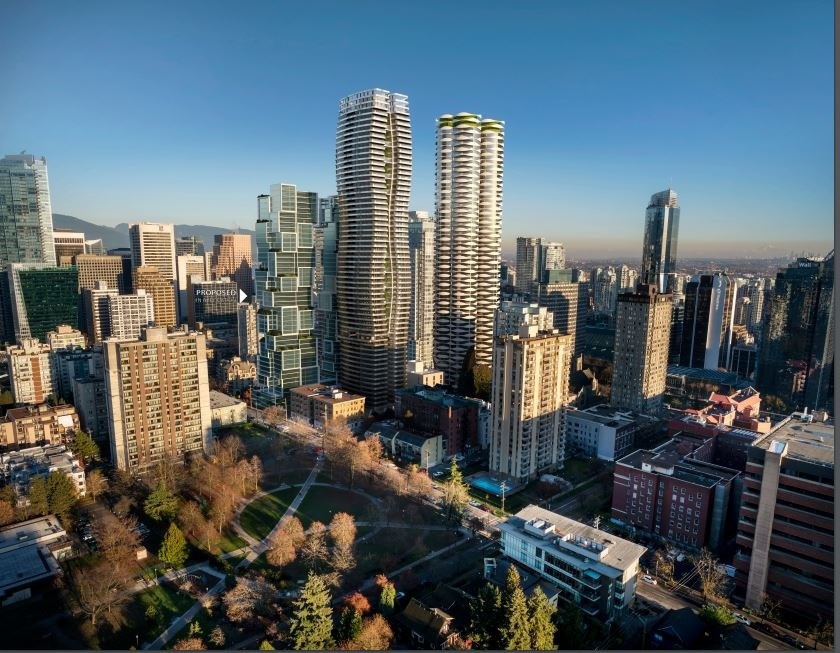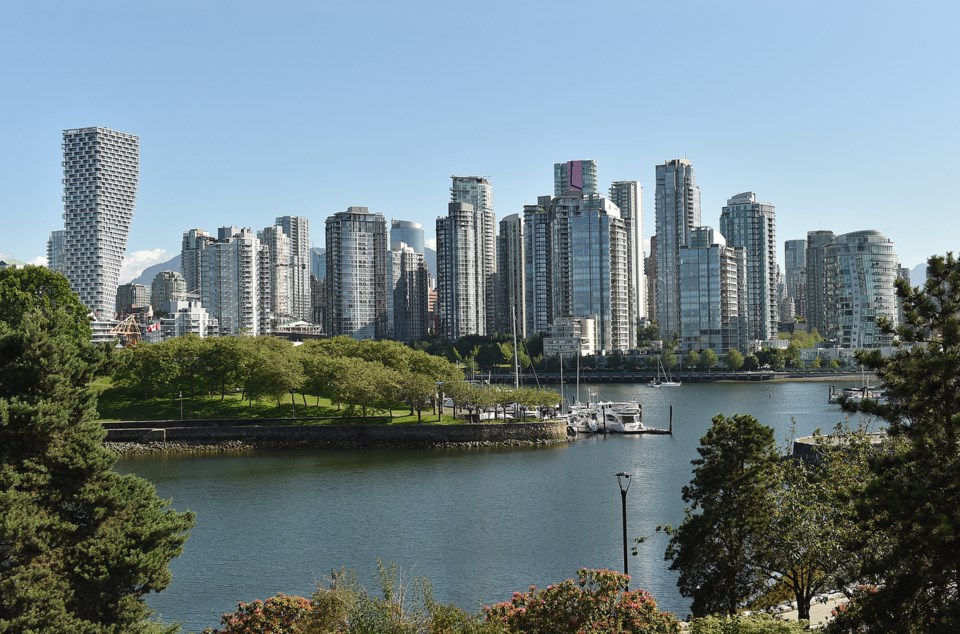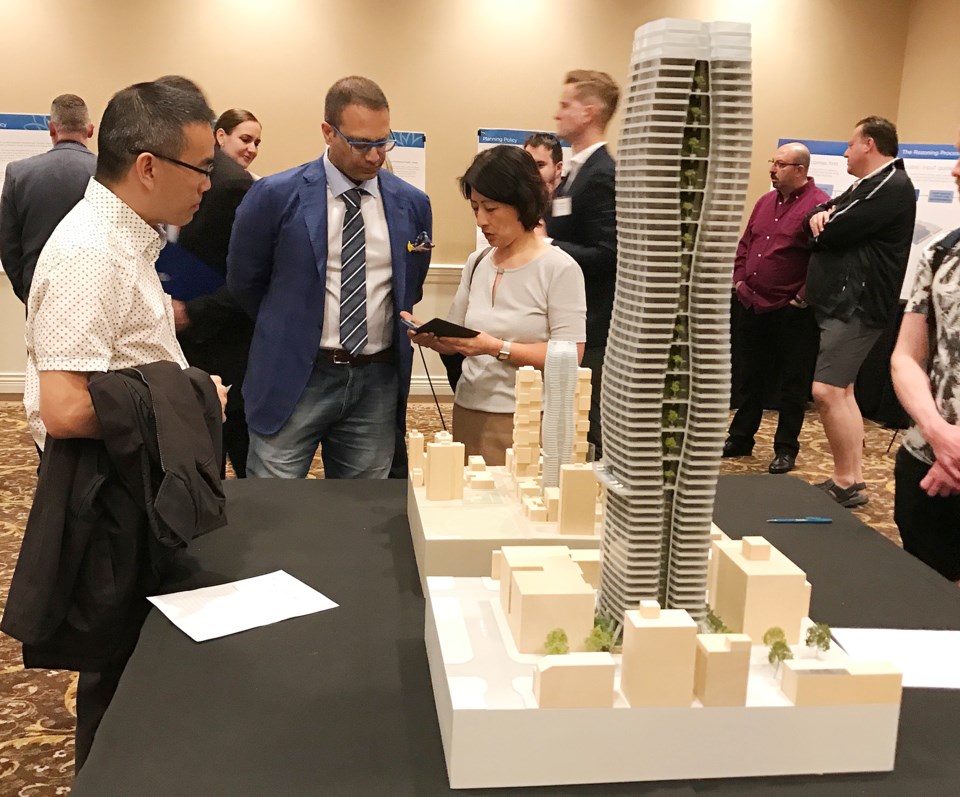Iconic. Simple. Clean. That’s how architect Gwyn Vose of IBI Group describes the 60-storey residential tower Henson Developments is proposing for 1059 to 1075 Nelson St. near Thurlow Street in the city’s West End.
If the project is approved, it will be among the tallest buildings in Vancouver, reaching a height of 555.5 feet — or 585.5 feet to the top of its appurtenance (the part of the structure above the highest occupied level where mechanical equipment that supports the building is located).
Tom Wright of U.K.-based WKK Architecture designed the Nelson Street tower, which is being built to Passive House standards, while Vancouver-based IBI Group is the executive architect whose role is to help the design architect with local policies and regulations.
The building, featuring a total of 485 units, including 113 social housing units, 49 market rentals and 323 market condos, was unveiled at an open house last week. Its wavy shape frames a curvy column of greenery down its centre.
Vose, representing IBI Group at the open house, says the tower’s design is reminiscent of the coastline.
“Tall buildings want to be simple and elegant,” he added.
The building’s proposed height puts it on par with the neighbouring “Butterfly” building, a 57-storey luxury condo tower Westbank is constructing at 969 Burrard St.

Currently, Vancouver’s two tallest buildings are the 60-storey, 659-foot-tall Shangri-La at 1128 West Georgia and the 63-storey Trump Tower, measuring 616 feet, at 1161 West Georgia.
Several city policies, which council has set over time, regulate building height in Vancouver, explained Jason Olinek, the City of Vancouver’s acting assistant director of planning for development planning.
The city’s district schedule outlines the base zoning for a site, while the rezoning process allows developers to apply to exceed the permitted height and density. That’s limited by urban design guidelines and, during the rezoning process, various factors are taken into account, including public opinion, shadowing, and view cones that protect views of the Burrard Inlet, the North Shore and the mountains.
The Higher Buildings Policy is another regulation governing height. It’s a set of guidelines used in conjunction with other policies for reviewing buildings seeking significant increases over existing height limits.
Adopted in 1997, and amended several times, the policy identifies certain areas and sites where consideration can be given for buildings that are taller than the general downtown zoning height limits or for those entering the Queen Elizabeth Park or other council approved view corridors.
“The intent of these guidelines is to mark the prominence of the Central Business District in our downtown skyline, while also providing opportunities for strategically placed height at the prominent “gateways” to mark the entry into downtown: the Burrard Bridge, the Granville Bridge, and the Georgia Gateways in Northeast False Creek and at West Georgia and Pender streets,” the policy states.
The tallest building permitted under the policy is 700 feet.

Henson Developments’ rezoning application is being considered under the West End Community Plan, which allows for consideration of up 550 feet at that location. Buildings at this height must also follow the Higher Buildings Policy, which applies to buildings which extend into the Queen Elizabeth Park view cone.
Under the policy, building proposals at 550 feet undergo an enhanced review by the Urban Design Panel that includes the addition of two local architects appointed to the panel by the Director of Planning. The proposed Nelson Street tower has been allowed an additional five feet, to 555 feet, in consideration of the applicant’s commitment to build to a Passive House sustainable building standard.
How does Vancouver measure up?
How many storeys a building’s height equates to depends on a variety of factors including the type of use, such as office or residential whose floor-to-ceiling heights differ, the type of construction, the preferences of the developer and architect, and rooftop appurtenances.
“Tall,” however, is relative when you consider the height of the highest skyscrapers in Canada and the rest of the world.
Vancouver’s policies mean even Burnaby is exceeding this city on the tall building front.
Onni Group’s 64-storey highrise at 2 Gilmore Place will be 708 feet from the lobby level to the top of the appurtenance. When it’s completed, it will be the tallest residential tower in Western Canada.
That will eventually be surpassed by Concord Pacific’s planned new 65-storey building on the old Sears site at Metrotown, which will hit 723 feet.
At 2,717 feet, however, Dubai’s 163-storey Burj Khalifa in the United Arab Emirates would tower over those buildings, as would Shanghai Tower in China, which is 128 floors and reaches 2,073 feet. Abraj Al-Bait Clock Tower in Mecca, Saudi Arabia, measures 1,971 feet with 120 floors.
But really tall buildings need a large floor plate, noted Vose, and require more elevators to bring people up and down, which takes away from saleable space.
Vose, however, isn’t concerned that Vancouver isn’t competing with international cities like Dubai in the race for the highest tower.
He’s pleased that Vancouver’s urban planning approach, dubbed Vancouverism, has produced slim, smaller footprint buildings with a lot of space between them.
“I think it’s a good idea to have thinner towers with smaller floor plates,” he said. “It’s what’s made Vancouver what it is, and Vancouver is a pretty amazing place because of that.”
VANCOUVER TALL TOWERS
- Shangri-La (659 feet) at 1128 West Georgia. Completed 2008
- Trump Tower (616 feet) at 1161 West Georgia. Completed 2017
- The Butterfly (556 feet) at 969 Burrard St. Under Construction
- 1075 Nelson (555.5 feet). Proposed
- 1133 Melville (550 feet). “The Stack” office building. Under Construction
- One Burrard Place (550 feet). Under Construction
- 601 Beach (535 feet). Proposed
- Private residences of Hotel Georgia (518 feet) at 667 Howe St. Completed 2013
- Vancouver House (507 feet). Under Construction
- 1450 West Georgia. (497.3 feet). Proposed
- One Wall Centre (491 feet). Completed 2001
- Shaw Tower (489 feet). Completed 2004
- Harbour Centre (481 feet). Completed 1977



